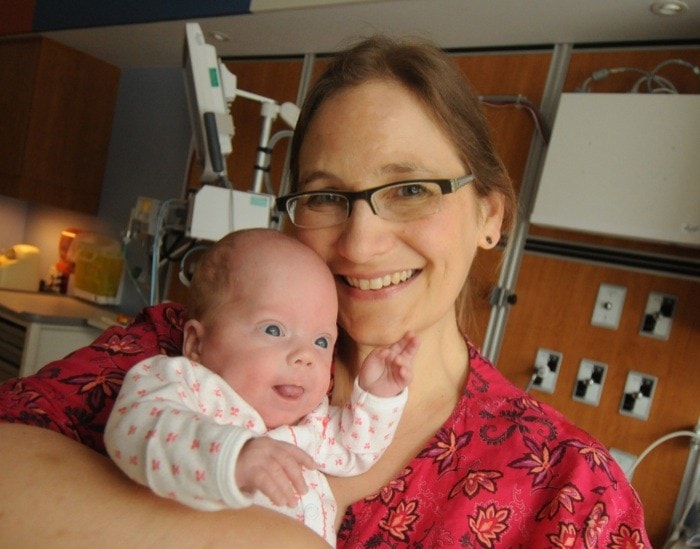As the designated Regional Pediatric Centre in the Fraser Health region, Surrey Memorial Hospital offers specialized and unique care to babies, children and youth from Burnaby to Hope. The Leader provides an inside look at how B.C.’s second-largest hospital has grown and adapted to treat its youngest and most vulnerable patients.
Joy Elizabeth Anonby couldn’t wait to make her debut.
Her parents and two older brothers were eager to meet her, too. But they weren’t prepared – yet.
It was April 7, 2015 wh en Joy decided to take centre stage and emerge from her mom’s womb. The length of a man’s shoe, she weighed about as much as a bottle of water.
en Joy decided to take centre stage and emerge from her mom’s womb. The length of a man’s shoe, she weighed about as much as a bottle of water.
Eleven days earlier, complications had landed mom Kirsten Anonby in hospital. “Keep that baby in,” doctors urged her.
Joy only complied for a week-and-a-half and was born at 25 weeks – nearly four months before her due date.
At just under 36 centimetres (14 inches long), she weighed one kilogram (2.2 pounds).
With a pair of boys already running in circles at home, Kirsten and her husband David thought they were relatively prepared to welcome a third child. Until they had a preemie.
“After having two normal babies, it’s a very different,” said Kirsten. “You don’t get to hold your baby. You don’t get to smell her head.”
Unlike her other births, the Surrey mom was also greeted by an army of hospital staff, including doctors, nurses, neonatologists, respiratory therapists, physiotherapists, occupational therapists, feeding specialists and more.
“I was amazed how many people wanted to come talk to me when Joy was born,” smiled Kirsten, who called Surrey Memorial Hospital’s Neonatal Intensive Care Unit (NICU) home for about three-and-a-half months.
“It functions communally in that sense.”
At birth, Joy was considered a Level 3 preemie, meaning she wasn’t able to breathe on her own and required a ventilator and feeding tube, as well as blood pressure and other medications.
Premature babies are categorized based on age and weight, as well as their respiratory, neurological and cardiovascular status. While Level 1s don’t need a lot of support, Level 2s usually have trouble breathing and require extra intravenous nutrition. Babies born at Level 4 are critically ill, requiring surgeries or with heart defects, and must be treated at B.C. Children’s Hospital.
SMH and Royal Columbian Hospital have the only NICU wards in the region able to provide around-the-clock care for Level 3 infants, which often come from across the province.
Located in the Critical Care tower that opened at SMH in 2014, the Neonatal Intensive Care Unit is divided into four “pods” with 12 rooms apiece, allowing for 48 premature babies to be housed at one time. One of the 12-bed wings is not yet open, but there are still between 25 and 32 preemies on the ward on any given day.
The previous Surrey NICU ward had just 20 beds and was routinely at or over capacity, often with families sharing rooms. All the rooms on the new ward are private and large enough to accommodate twins.
The state-of-the-art facility is designed to not only consider health care workers’ needs, but those of the baby and parents. The touches are subtle, like light fixtures on the wall that shine upward so as to not glare down on newborns lying in incubators or bassinets. Sound-proofing panels surreptitiously line the rooms, which are furnished with sofa beds and recliner chairs for breastfeeding.
“We found the facility here to be amazing,” said Kirsten.
There’s even a neonatal and pediatric pharmacy down the hall, specializing in preparing the proper medications and precise doses for the hospital’s tiniest, most vulnerable patients.
Due to Joy’s high level of need, K irsten spent many long weeks in the NICU (in incubator, below), routinely staying overnight three to four times a week, the back-and-forth travel between home and hospital made easier by the fact her family lives in Surrey. (Parents also have the on-site Ronald McDonald Family Room as a respite).
irsten spent many long weeks in the NICU (in incubator, below), routinely staying overnight three to four times a week, the back-and-forth travel between home and hospital made easier by the fact her family lives in Surrey. (Parents also have the on-site Ronald McDonald Family Room as a respite).
The length of a baby’s stay in the NICU can vary from hours to several months, depending on their health needs.
Kirsten recalls the many milestones as Joy grew and gained strength. Holding her new daughter – usually tucked safely in her incubator – rated high, but was still scary with the web of breathing, feeding and monitoring lines and cables still attached to her little body.
It was “lovely” the day Joy came off the respirator.
“The first time I held her without that, I cried… I got to touch her head,” Kirsten said.
Nurse Brenda Haan, a clinical nurse educator at SMH since 2001, said staff inevitably bond with the families and their tiny bundles.
“We get attached to those babies,” she says, smiling and acknowledging that depending on the family’s circumstances, nurses may spend more time with the infants than their parents.
When Joy finally got the okay to go home, she was over three-and-a-half months old and weighed more than eight pounds.
Wide-eyed and attentive, she was able to hold her head high – ready to make another big entrance: at home.
ON WEDNESDAY: SURREY'S KIDS-ONLY ER
Other stories in this series:
• Surrey's kids-only ER sees 100+ children per day
• 'Something right happens here'
